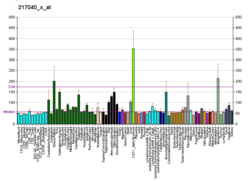Protein SOX-15 is a protein that in humans is encoded by the SOX15 gene.[5][6][7]
This gene encodes a member of the SOX (SRY-related HMG-box) family of transcription factors involved in the regulation of embryonic development and in the determination of the cell fate. The encoded protein may act as a transcriptional regulator after forming a protein complex with other proteins.[7]
See also
[edit]References
[edit]- ^ a b c GRCh38: Ensembl release 89: ENSG00000129194 – Ensembl, May 2017
- ^ a b c GRCm38: Ensembl release 89: ENSMUSG00000041287 – Ensembl, May 2017
- ^ "Human PubMed Reference:". National Center for Biotechnology Information, U.S. National Library of Medicine.
- ^ "Mouse PubMed Reference:". National Center for Biotechnology Information, U.S. National Library of Medicine.
- ^ Meyer J, Wirth J, Held M, Schempp W, Scherer G (Jan 1997). "SOX20, a new member of the SOX gene family, is located on chromosome 17p13". Cytogenet Cell Genet. 72 (2–3): 246–9. doi:10.1159/000134200. PMID 8978787.
- ^ Critcher R, Stitson RN, Wade-Martins R, Easty DJ, Farr CJ (Oct 1998). "Assignment of Sox4 to mouse chromosome 13 bands A3-A5 by fluorescence in situ hybridization; refinement of the human SOX4 location to 6p22.3 and of SOX20 to chromosome 17p12.3". Cytogenet Cell Genet. 81 (3–4): 294–5. doi:10.1159/000015052. PMID 9730625. S2CID 46849443.
- ^ a b "Entrez Gene: SOX15 SRY (sex determining region Y)-box 15".
Further reading
[edit]- Wilson M, Koopman P (2003). "Matching SOX: partner proteins and co-factors of the SOX family of transcriptional regulators". Curr. Opin. Genet. Dev. 12 (4): 441–6. doi:10.1016/S0959-437X(02)00323-4. PMID 12100890.
- Schepers GE, Teasdale RD, Koopman P (2002). "Twenty pairs of sox: extent, homology, and nomenclature of the mouse and human sox transcription factor gene families". Dev. Cell. 3 (2): 167–70. doi:10.1016/S1534-5807(02)00223-X. PMID 12194848.
- Gozé C, Poulat F, Berta P (1993). "Partial cloning of SOX-11 and SOX-12, two new human SOX genes". Nucleic Acids Res. 21 (12): 2943. doi:10.1093/nar/21.12.2943. PMC 309692. PMID 8332506.
- Hiraoka Y, Ogawa M, Sakai Y, et al. (1998). "Isolation and expression of a human SRY-related cDNA hSOX20". Biochim. Biophys. Acta. 1396 (2): 132–7. doi:10.1016/s0167-4781(97)00186-3. PMID 9540826.
- Cremazy F, Soullier S, Berta P, Jay P (1998). "Further complexity of the human SOX gene family revealed by the combined use of highly degenerate primers and nested PCR". FEBS Lett. 438 (3): 311–4. Bibcode:1998FEBSL.438..311C. doi:10.1016/S0014-5793(98)01294-0. PMID 9827568. S2CID 551497.
- Vujić M, Rajić T, Goodfellow PN, Stevanović M (1999). "cDNA characterization and high resolution mapping of the human SOX20 gene". Mamm. Genome. 9 (12): 1059–61. doi:10.1007/s003359900925. PMID 9880678. S2CID 792477.
- Miyashita A, Shimizu N, Endo N, et al. (1999). "Five different genes, Eif4a1, Cd68, Supl15h, Sox15 and Fxr2h, are clustered in a 40 kb region of mouse chromosome 11". Gene. 237 (1): 53–60. doi:10.1016/S0378-1119(99)00301-7. PMID 10524236.
- Strausberg RL, Feingold EA, Grouse LH, et al. (2003). "Generation and initial analysis of more than 15,000 full-length human and mouse cDNA sequences". Proc. Natl. Acad. Sci. U.S.A. 99 (26): 16899–903. Bibcode:2002PNAS...9916899M. doi:10.1073/pnas.242603899. PMC 139241. PMID 12477932.
- Gerhard DS, Wagner L, Feingold EA, et al. (2004). "The status, quality, and expansion of the NIH full-length cDNA project: the Mammalian Gene Collection (MGC)". Genome Res. 14 (10B): 2121–7. doi:10.1101/gr.2596504. PMC 528928. PMID 15489334.





